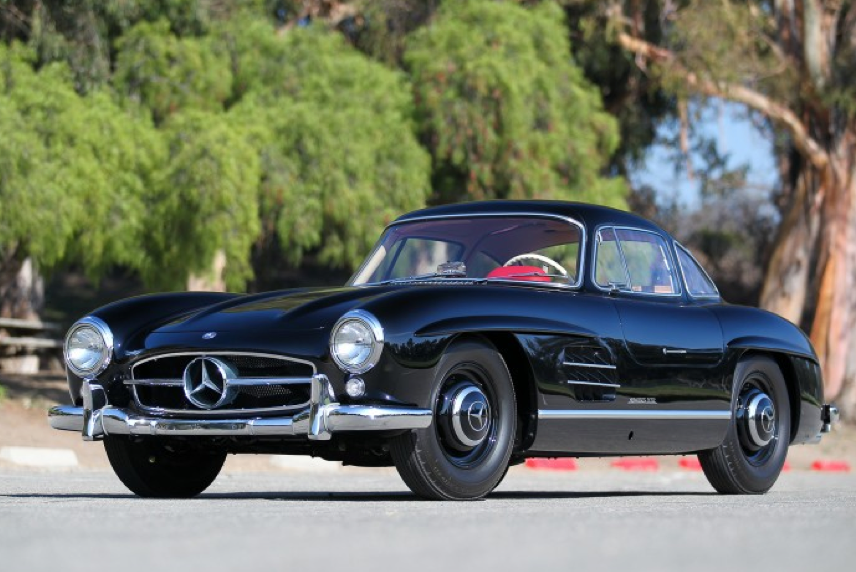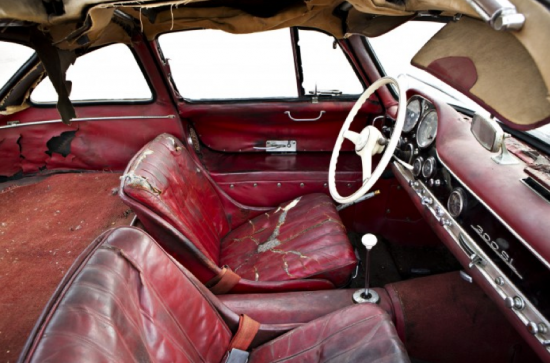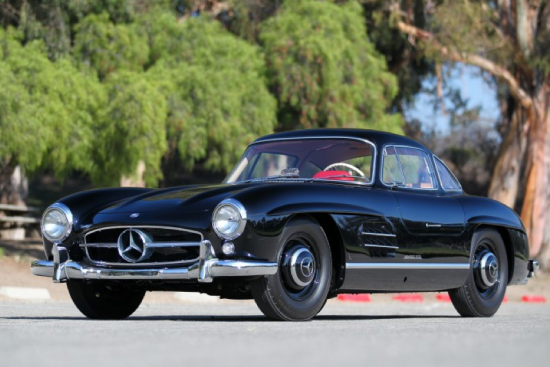by Mike –
The trend toward original cars being worth more than restored cars has been creeping up on us for a while – at least in the US. I think collector car enthusiasts in Europe have long valued originality more than US collectors.
I wrote about two 1965 Shelby GT350s in 2012 that clearly demonstrated this trend in the US.
But now it is out in the open with the sale in Arizona recently at the Gooding auction of two 1956 Mercedes-Benz 300SL coupes – one fully restored and the other almost completely original. They were even the same color combination although the restored car had an interior color change, which can be done on a restoration but not on an original car.
The restored 300SL sold for $1,402,500 and the un-restored version sold for $1,897,500 at the same auction.
This is a hefty 35% premium for originality. The irony is that the owner of the restored car has much more money into his 300SL but he received a lot less!
This transition in thinking by classic car collectors raises some questions, in my mind at least:
1) Will there be an increase in fake originality and fake patina on classic cars for sale?
2) Will there be a specialty business in restoration work such that it does not look like a restoration has been done?
3) Will the Concours d’Elegance events modify their love for over the top restorations? In other words, will an un-restored car ever win best in show at Pebble Beach?
4) Will the classic car price guides add an “original” category? The way they are structured now original cars are valued less than restored cars because they have suffered the wear of time and miles.
5) Will this trend harm the business of restoration shops? Or will the work migrate to originality maintenance? “Originality maintenance” is a term that I just made up but I suspect it will catch on.
6) Will this trend hurt the business of car polish and cleaning products companies or will they develop new, special products that help maintain that “original look”?
7) Will owners drive their original cars more because the wear and tear will not degrade the value? It may actually increase the value!
8) If a classic car has an older restoration that is showing it’s age should the owner restore it again or is the older restoration more valuable?
9) If parts of the original car are deteriorating beyond use or aesthetics how does the owner make the best decision as what to restore or not?
10) Is a partial restoration better than a full restoration, where some parts of the car are left original and other parts are restored to as new?
In the Comments – let us know what you think and if you have other questions about this originality trend.





Mike,
I think the game will move on, with a maturing outlook on original in usable condition.
A car must be able to be used as the maker intended for it to have full value.
The focus will become on honest repair rather than replacement.
The conservation ethic will spread as it has done for years on old furniture, old buildings and old works of art.
Provenance will become vital in identifying genuinely original cars.
An unrestored car will win Pebble Beach, as unrestored cars have already won other major US concours recently.
The recent Simeone Foundation book -‘the Stewardship of Historically Important Automobiles’ – focussed on the philosophy and value underlying this approach. The book will be supplemented with other more practical books about the repairs that can be done without compromising originality, but which allow the car to be seen as a beautiful object as opposed to a tarnished one.
It is acceptable to repair paint, but only after the original has been documented, analysed and carefully matched in places where the original aesthetic has been lost.
It is acceptable to replace mechanical components that were designed to have a service life on the car.
It is not acceptable to introduce higher levels of finish than the factory used.
Inevitably, restoration shops and auctioneers will look to make capital from this situation, as you have already lamented. This will be offset by an increasing awareness among buyers that originality claims need to be investigated. A little caution will enter the market as a glut of suspiciously faded cars enter the arena. It will take years for the fakes and the reproductions to be identified, just as it has in other art markets.
In the end, the winners will be the genuinely original cars that might previously have been over restored, and such cars will now become the holy grail of classic car collectors.
Long may it remain so.
Well said.
Well put Paul. We are witnessing many changes in the car market, many of them as a result of Internet influence. Instead of being local or possibly even national, the classic car market has evolved into global. What we are experiencing is an influence of variety of global views and trends (speaking of cars, of course)
I too agree that the trend will be towards keeping as much of the car original as possible. “Originality maintenance” or perhaps “originality preservation” fits that description. The cost of repairs of a part far gone exceeds cost of replacement. The restoration houses are equipped to handle that but will the new owners be willing to spend 2-3 times the $ to repair the part to keep it original and accept the prolonged time periods of preservation? Partially restored vehicles will also get their day under the sun. We may even see gradations of % of ordinal parts used in restoration correlate with price, I.e. the higher % of ordinal parts retention, the higher the price.
I don’t expect to see many of these ” originally preserved” cars on the road. I presume that originality will need to be more than skin deep, and as such many mechanical components will be left in their original condition thus putting the safe operation of such vehicle on public roads into question. Also, the additional wear on the original mechanical components will detract from the value of the vehicle.
As far as multiple restoration go, the car is original only once. As long as all restorations are performed by professionals and are well documented, I don’t see why should any subsequent restorations reflect negatively on the price.
Mike, my estimation- this discussion is about control. You trust who ‘restored’ (& isn’t that a vague word ?!) what you have & if you are so inclined at some point or time you pass that on to the next person who wishes to own what you no longer desire. They buy into what you offer. Original is just that & promises a greater range of speculation, take the money out of speculation & (it) still remains the same. One should prefer ‘restored’ over ‘original’ if they do not possess the skills to control what they wish to be the end product.
Their are different levels or “original”. Some areas of the car may have been restored and others remain original – valuing that and verifying that will be a challenge. Before this transition to original values being so much more than a restored car this problem was not as important as it is now.
As time goes on, originals become more and more rare and just naturally go up in value. And why not, you can always restore but you can NEVER go back to original. The more original, the better.
Spring’s here again it’s “Mustang” season!
Found this website and article great reading.
I couldn’t agree more.
There was a time when people cherished and valued their cars.
Washed and waxed them (with Compound Wax) every chance they got.
Made the chrome shine like a mirror.
Heck my mom even got into the small crevasse with a Q-Tip.
Everything that could be done to take care of it she did.
Never saw salt a day in its life.
She still has her Mustang. Her baby since ’67.
Now people think if they have enough money they can go and buy everything.
The fastest, rarest, the “best” in show. Buy themselves a status symbol.
But do they truly love the car, the “Mustang”.
The memories, the pride.
It would be great if the originals and their owners, were looked up to
a bit more.
Given a salute for taking care of those great old cars so they’re still some around.
Not modified or taken apart and changed.
Just cherished.
As my family does.
Thanks
I agree with you Mike. The different variables of ‘original’.
My case for example…
I have a 1-owner, (other than myself) virtually complete, (no passenger seat nor engine) 67 VW bug. It has original radio with dealership installed AC. The vehicle had been weathered for 32 years. Some say it’s the most perfect patina they have ever seen.
I have/had total plane of a complete vin restoration. Everything to how she came from Germany. Now second thoughts are with me.
I do have to check the numbers on the rebuilt/stock engine I’ve purchased to see if they are time related to the car itself to be able to say it is original….right? Or is that just a flat-out, not original car, PERIOD?? (even if numbers match……(?))
Also I will have to repair 2 area of the pan of rust. ….original????
I think to myself, as I write this explaining what I’ve got that maybe…just maybe this car is going to have a much greater value restored…..
Thought please. And thank you.
I Just bought a Lotus Esprit SE from 1992 here in Thailand and I would like to keep it for many years. There are only a couple Esprit SE here, and its been illegal for a few year to import any classic cars to the country. The car is in general in good condition but the paint has some little damages as well as the leather has gone from cream color to vomit yellow since it is now 26 years ago it was made.
I would like to re-paint the exterior with the exact same color and redo the interior back to the old cream color. Would this increase the value with such a restoration? If i decided to change the original color on the interior, to a more modern upholstery does that de-value the car?
Would like to have the car in perfect condition. Suggestions?